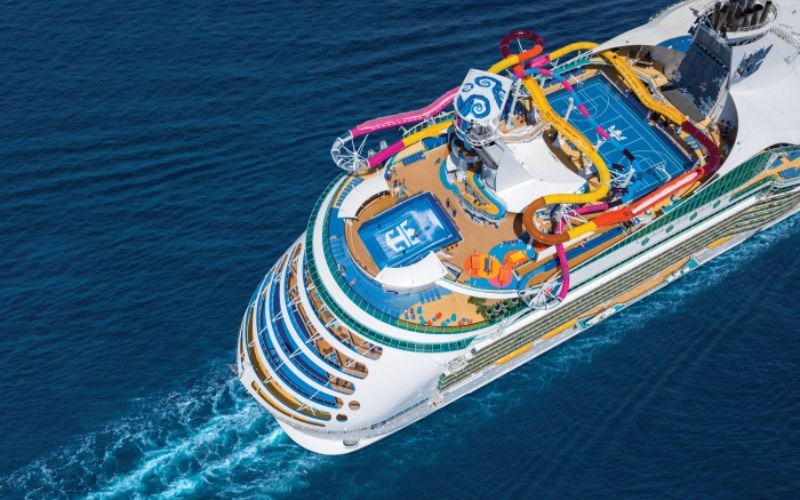The RMS Titanic, a name synonymous with grandeur and tragedy, often comes to mind when we think of large cruise ships. In 1912, it was indeed the largest passenger liner afloat, a marvel of its time. However, to equate the Titanic to today’s modern cruise ships is to overlook a century of maritime evolution. While the Titanic was impressive for its era, contemporary cruise liners dwarf it in size, technology, safety, and passenger experience. Let’s delve into a detailed comparison to truly understand how vastly different cruising is today compared to the era of the “unsinkable” Titanic.
 Aerial view of Navigator of the Seas – showcasing the scale of a modern cruise ship
Aerial view of Navigator of the Seas – showcasing the scale of a modern cruise ship
Size and Passenger Capacity: A Matter of Scale
The Titanic, at 882 feet in length, was a behemoth for its time. It carried approximately 2,200 passengers and crew. Consider this in contrast to modern giants like Royal Caribbean’s Icon of the Seas, which measures a staggering 1,198 feet long and boasts a gross tonnage of 248,663. These modern vessels can comfortably accommodate over 6,000 passengers and crew. The sheer scale difference is immense; modern ships are not just longer, but also wider and taller, featuring numerous decks packed with amenities unimaginable in the Titanic’s era. This expansion in size directly translates to a greater array of facilities and experiences for passengers.
Safety Features: From Limited Lifeboats to Advanced Technology
Perhaps the most critical area of divergence lies in safety. The Titanic’s infamous sinking highlighted critical safety deficiencies of the time, most notably the insufficient number of lifeboats. Modern cruise ships operate under vastly different safety regulations, born from lessons learned from tragedies like the Titanic. Today’s liners are equipped with a full complement of lifeboats and life rafts capable of accommodating every person on board. Beyond this fundamental improvement, modern ships incorporate advanced navigation systems, including GPS, radar, and sonar. Satellite communication ensures constant contact with shore, enabling real-time monitoring and rapid emergency response. Rigorous safety drills for passengers and crew are mandatory, and ships undergo frequent, stringent inspections to comply with international maritime safety standards, far exceeding those in place in 1912.
Technology and Innovation: A Century of Progress
The technological landscape has transformed dramatically since the Titanic’s maiden voyage. While the Titanic boasted innovations like electric lighting and wireless telegraphy, modern cruise ships are floating cities of technological marvel. Onboard Wi-Fi, interactive touch screens, and smartphone apps are standard, allowing passengers to stay connected, manage their itineraries, and access ship information effortlessly. Digital key systems replace traditional keys, and high-speed internet facilitates real-time communication and social media sharing. Furthermore, ship operations are heavily reliant on sophisticated computer systems for navigation, engine control, and weather forecasting, enhancing both efficiency and safety.
Comfort and Luxury: Redefining Opulence
The Titanic was celebrated for its luxurious accommodations, particularly in first class. However, modern cruise ships have redefined the very concept of luxury at sea. From spacious staterooms, many with private balconies offering stunning ocean views, to opulent suites with personalized butler service, the range of accommodations caters to diverse preferences and budgets. Gourmet dining is a cornerstone of the modern cruise experience, with multiple restaurants offering diverse cuisines and dining styles. World-class entertainment, including Broadway-style shows, casinos, and themed bars, ensures there’s never a dull moment. Spas, fitness centers, and multiple swimming pools further enhance the onboard experience, offering unparalleled levels of comfort and relaxation.
Environmental Sustainability: Navigating a Greener Future
Environmental consciousness is a relatively recent but crucial consideration in the cruise industry. The Titanic era lacked any real focus on environmental impact. Modern cruise lines are increasingly investing in sustainable practices. Modern ships incorporate advanced wastewater treatment systems to minimize ocean pollution, energy-efficient propulsion systems to reduce fuel consumption, and LED lighting to conserve energy. Recycling programs are common, and some ports offer shore power connections, allowing ships to reduce emissions while docked. The industry is also exploring alternative fuels and technologies to further lessen its environmental footprint and protect marine ecosystems, a stark contrast to the practices of a century ago.
Global Accessibility: Voyages to Every Corner of the World
The Titanic’s voyages were primarily transatlantic crossings between Europe and North America. Modern cruise ships offer a truly global reach. Itineraries span all seven continents, from the Caribbean and Mediterranean to Alaska, the South Pacific, and even Antarctica. This vast network of destinations makes cruising accessible to a much wider audience and offers a diverse range of cultural and geographical experiences. Shore excursions in ports of call further enrich these voyages, allowing passengers to explore destinations in depth, something unimaginable with the limited routes of the Titanic’s time.
Dining Options: A Culinary World Tour Onboard
Dining on the Titanic was structured around class, with grand dining saloons serving elaborate meals. Modern cruise ships offer an explosion of culinary choices. Passengers can select from gourmet restaurants, casual buffets, specialty venues focusing on specific cuisines (Italian, Asian, etc.), and even 24-hour room service. The emphasis is on variety and catering to diverse tastes and dietary needs. World-class chefs curate menus, and many cruise lines partner with celebrity chefs to elevate the dining experience, moving far beyond the more traditional, class-based dining of the Titanic.
Entertainment and Activities: Non-Stop Engagement
Entertainment on the Titanic was relatively limited compared to today’s standards. Modern cruise ships are designed to be entertainment hubs. Broadway-caliber shows, live music venues, comedy clubs, and themed parties provide nightly entertainment. Daytime activities are equally abundant, ranging from cooking classes and dance lessons to fitness programs, water sports, and enrichment lectures. Casinos, movie theaters, and interactive games further add to the options. The sheer volume and variety of entertainment and activities ensure that passengers of all ages and interests are constantly engaged and entertained.
Health and Wellness: Prioritizing Passenger Well-being
While the Titanic had basic facilities, modern cruise ships place a significant emphasis on health and wellness. Beyond standard spa treatments, modern ships feature comprehensive wellness facilities. Saunas, steam rooms, and hot tubs are common, alongside extensive spa menus offering massages, beauty treatments, and therapies. Fully equipped gyms, jogging tracks, and group exercise classes cater to fitness enthusiasts. Yoga and meditation classes promote mental well-being. This holistic approach to health and wellness is a far cry from the limited provisions available on ships like the Titanic.
Accessibility and Inclusivity: Cruising for Everyone
Perhaps one of the most significant societal shifts reflected in modern cruise ships is the focus on accessibility and inclusivity. The Titanic era was marked by significant social inequalities, and accessibility for people with disabilities was not a consideration. Modern cruise ships are designed to be accessible to all passengers, including those with disabilities. Wheelchair-accessible cabins, public areas, and amenities are standard. Cruise lines provide specialized services and assistance to ensure all guests can enjoy a comfortable and memorable vacation, regardless of their physical abilities. This commitment to inclusivity marks a profound departure from the exclusivity of early 20th-century ocean liners like the Titanic.
In conclusion, while the Titanic holds a legendary place in maritime history and popular imagination, comparing it to a modern cruise ship reveals a chasm of difference. Today’s cruise liners are not just larger; they represent a century of advancements in safety, technology, comfort, entertainment, and environmental consciousness. The experience of cruising has been fundamentally transformed, offering a level of luxury, safety, and global accessibility that would have been unimaginable in 1912. The debate isn’t really a contest; modern cruise ships have unequivocally surpassed the Titanic in every measurable aspect, offering a vastly superior and safer experience for today’s traveler.
